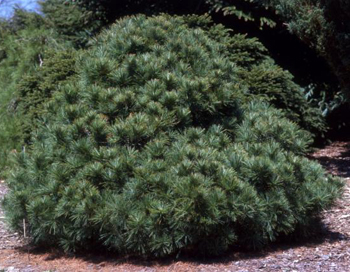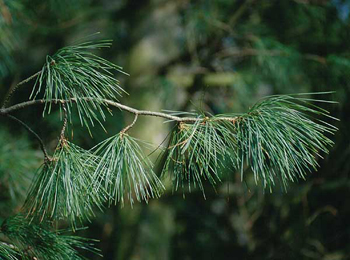Contents:
Common Names | Parts Usually Used | Plant(s) & Culture | Where Found | Medicinal Properties
Legends, Myths and Stories | Uses | Formulas or Dosages | How Sold | Bibliography
Scientific Names

- Pinus strobus L.
- Pinaceae
- Pine family
Common Names
- Deal pine
- Soft pine
Parts Usually Used
Inner bark, young shoots, twigs, pitch, leaves
Back to Top

Description of Plant(s) and Culture
White pine is a large North American evergreen tree; reaches a height of 150 feet or more, the tree is covered with deeply fissured, gray-brown bark. Its branches are arranged in regular whorls. The soft bluish-green, needle-like, linear leaves grow in clusters of five, the clusters spirally arranged on the branches. The male flowers grow in axillary, catkinlike cones, the female in slightly larger lateral or nearly terminal cones. The slender, cylindrical seed cones are from 3-8 inches long and are often curved. The winged seeds are brown, mottled with black.
Back to Top
Where Found
Grows from Newfoundland to Georgia mountains and central Iowa, west to northern Illinois.
Back to Top
Medicinal Properties
Expectorant, demulcent
Back to Top
Legends, Myths and Stories
The Native Americans used white pine for making a bread from the ground-up bark.
Long been used for lumber and wood pulp, the timber has been used for ship masts, houses, other buildings.
Back to Top
Uses
The inner bark off white pine is a remedy for coughs and congestion due to colds and bronchitis, flu, croup, laryngitis, as a tea or as an ingredient in cough syrup. Some Native American tribes used the inner bark or the sap as a poultice or dressing for wounds and sores. Pitch poulticed to “draw out” boils, draw embedded splinters, felons, abscesses, also used for rheumatism, broken bones, cuts, bruises, and inflammation. Twig tea used for kidney and lung ailments. Bark and/or leaf tea used for sore throats, poulticed for headaches. Combined with uva ursi (bearberry), marshmallow, and poplar bark, it is excellent for diabetes.
A hot resin can be spread on a hot cloth and applied as you would a mustard plaster for treating pneumonia, sciatic pains, and general muscular soreness.
Back to Top
Formulas or Dosages
Infusion: steep 1 tsp. inner bark or young shoots in 1 cup water. Take a mouthful at a time, as needed. Add a little honey for sweetening if desired.
Tincture: a dose is from 2-10 drops in water.
Mixture: steep 1 tsp. white pine inner bark and 1 tbsp. each of wild cherry bark, sassafras bark, and American spikenard root in 1 pint of boiling water for 30 minutes. Take 1 tsp. every hour.
Back to Top
How Sold
A ready-made combination of pine with other herbs is available at many herb shops, with the directions for use on the container.
Back to Top
Bibliography
![]() Back to Eden
Back to Eden, by Jethro Kloss; Back to Eden Publishing Co., Loma Linda, CA 92354, Original copyright 1939, revised edition 1994
![]() The Herb Book
The Herb Book, by John Lust, Bantam Books, 666 Fifth Avenue, New York, NY. copyright 1974.
![]() Eastern/Central Medicinal Plants
Eastern/Central Medicinal Plants, by Steven Foster and James A. Duke., Houghton Mifflin Company, 215 Park Avenue South, New York, NY 10000
![]() Indian Herbalogy of North America
Indian Herbalogy of North America, by Alma R. Hutchens, Shambala Publications, Inc., Horticultural Hall, 300 Massachusetts Avenue, Boston, Massachusetts 02115, 1973
![]() American Folk Medicine
American Folk Medicine, by Clarence Meyer, Meyerbooks, publisher, PO Box 427, Glenwood, Illinois 60425, 1973
![]() Webster’s New World Dictionary
Webster’s New World Dictionary, Third College Edition, Victoria Neufeldt, Editor in Chief, New World Dictionaries: A Division of Simon & Schuster, Inc., 15 Columbus Circle, New York, NY 10023
 How Indians Use Wild Plants for Food, Medicine & Crafts
How Indians Use Wild Plants for Food, Medicine & Crafts, by Frances Densmore, Dover Publications, Inc., 180 Varick Street, New York, NY 10014, first printed by the United States Government Printing Office, Washington, in 1928, this Dover edition 1974
 An Instant Guide to Medicinal Plants
An Instant Guide to Medicinal Plants, by Pamela Forey and Ruth Lindsay, Crescent Books (January 27, 1992).
![]() The Yoga of Herbs: An Ayurvedic Guide to Herbal Medicine
The Yoga of Herbs: An Ayurvedic Guide to Herbal Medicine, by Dr. David Frawley & Dr. Vasant Lad, Lotus Press, Twin Lakes, Wisconsin, Second edition, 1988.
![]() Planetary Herbology
Planetary Herbology, by Michael Tierra, C.A., N.D., O.M.D., Lotus Press, PO Box 325, Twin Lakes. WI 53181., Copyright 1988, published 1992
 The Rodale Herb Book: How to Use, Grow, and Buy Nature’s Miracle Plants (An Organic gardening and farming book)
The Rodale Herb Book: How to Use, Grow, and Buy Nature’s Miracle Plants (An Organic gardening and farming book), edited by William H. Hylton, Rodale Press, Inc. Emmaus, PA, 18049., 1974
